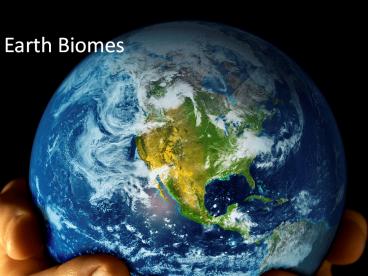Major Biomes of Earth - PowerPoint PPT Presentation
1 / 22
Title: Major Biomes of Earth
1
Earth Biomes
2
What is a BIOME?
- Biomes are large regions characterized by a
specific type of climate and the plants and
animals that live there. - Biomes are made up of many similar ecosystems.
Ecosystem are made up of communities of organisms
and its abiotic environment.
3
ABIOTIC and BIOTIC factors that affect ecosystems
and biomes
- Biotic
- Consumers animals
- Detritovores consume dead matter
- Producers plants
- Decomposers fungus, bacteria
- Decomposed organic matter once living
- Abiotic
- Sunlight
- Air
- Water (pH, salinity, dissolved oxygen)
- Soil
- Climate (temperature, rainfall, humidity)
- Chemicals
4
Major Biomes of Earth
5
Forests
- Mild temperatures
- Plentiful rainfall
- Major types of forests
- Deciduous forests
- Coniferous forests
- Tropical rain forests
6
Deciduous Forest
- Regions usually have 4 seasons a year
- Precipitation 76 cm to 250 cm yearly
- When the weather gets colder and trees lose their
leaves some animals migrate to warmer regions - Other animals hibernate
- Plants
- Deciduous trees (oak, maple, hickory)
- Animals
- Raccoon , Bald eagle, White tail deer , Red Fox
7
Deciduous Forest
Go.hrw.com
8
Coniferous Forest (Taiga)
- Temperatures Winters are very cold with only
snowfall, the summers are warm, rainy, and humid - Precipitation
- Plants (lichens, mosses, white spruce, mostly
coniferous trees) - Coniferous trees (evergreen) adaptations
- Wax gives protection from freezing temperatures
- Do not loose their leaves in the winter
- Not as many plant and animal species because many
cannot survive the extreme cold - Animals (lynx, wolverines, bobcate, rabbits,
deer) - animals in the taiga hibernate in the winter
9
Coniferous Forest
Go.hrw.com
10
Tropical Rain Forest
- Precipitation 200cm of rain each year
- Temperatures are warm and stable
- Tropical rain forests are lush, productive
ecosystems that contain more then half of all the
species that exist on Earth - Plants Vines, orchids, moss, ferns
- 700 species of trees and 1,000 species of
flowering plants - Adaptations orchids grow on trees to reach more
sun light - Animals Snakes, lizards, salamanders, monkeys,
jaguars, toucans - 150 different types of butterflies
11
Tropical Rain Forest
Go.hrw.com
12
Comparing Forests
FOREST Temperature Rainfall Soil
Deciduous 0C to 28C (32F to 82F) 76-250 cm per year very fertile, organically rich
Coniferous -10C to 15C (14F to 59F) 0-25 cm per year frozen
Tropical 25C to 28C (77F to 82F) 200 cm or more each year thin and nutrient poor
13
Grasslands
- Found between forests and deserts
- Flat or gently rolling hills
14
Grasslands
- There are grasslands on almost every continent
- Precipitation 25 cm 75 cm yearly
- They have a dry season with little to no rain
- This prevents larger plant from growing here
- Plants mainly grass
- Wheat, Oats, Barley, Corn
- Grasses have extensive root systems that can
absorb water when it rains and can withstand
drought during long dry spells - Animals
- Kangaroos, Wildebeests, Zebras, Prairie Dogs
- They eat the stems, leaves, and seeds of grass
plants
15
- Deserts
- Very dry and hot
- Organisms adapted to live in climate
16
Desert
- Driest biome on Earth
- Precipitation less then 25 cm yearly
- When it does rain, it evaporates rapidly, so the
soil retains very little moisture - Because there is little water, plants are spread
widely apart and the ground is mostly bare - Plants and adaptations
- The desert supports little plant life
- Cactus plants, spiny leaves are common
- large, shallow roots that quickly absorb water
- Animals and adaptations
- Few large animals are found because there is not
enough food or water to support them - Owls, iguanas, fox, lizards are common
- Kangaroo rat
- Never need to drink water -- they get moisture
from the food they eat - They are only active in the early morning or late
afternoon when the temperatures are less extreme
17
Deserts
Go.hrw.com
18
Tundra
- Very cold temperatures
- Little rainfall
- It is so cold here that trees dont even grow!
19
Tundra
- Is located near the north pole
- Cold, dry, treeless region and is covered with
ice most of the year - Winters are 6 to 9 months long
- Precipitation less then 25cm a year
- Plants
- lichens (reindeer moss) , True mosses, Grasses,
Small shrubs - Animals - in the summer
- Mosquitoes
- Birds (Geese, ducks, snowy owls)
- Mice, voles, lemmings, artic hares, caribou, musk
oxen
20
Marine
- Oceans of the world
- Wide variety of plant and animal species.
- There are 4 main parts, or zones, in the ocean.
Each zone has different plants and animals.
21
Marine Ocean Floor
22
Freshwater
- Rivers, lakes, streams
- Water is less than 1 salt.
- Animal Life Bass, catfish, leeches, river rats
- Plant Life algae, myrtle, deerflower, cattails































